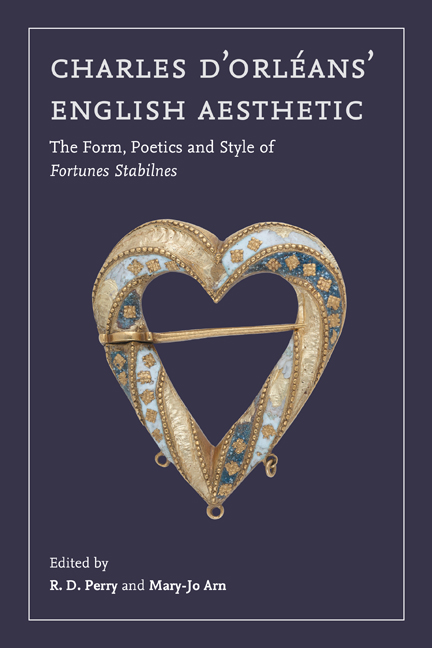Book contents
- Frontmatter
- Dedication
- Contents
- List of Illustrations
- List of Contributors
- Acknowledgements
- Abbreviations
- Introduction
- 1 The Two Dreams of Charles d’Orléans and the Structure of His English Book
- 2 Charles d’Orléans’ Cross-Channel Poetics: The Choice of Ballade Form in Fortunes Stabilnes
- 3 The English Roundel, Charles’s Jubilee, and Mimetic Form
- 4 A Grieving Lover: The Work of Mourning in Charles’s First Ballade Sequence
- 5 Charles d’Orléans’ English Metrical Phonology
- 6 The English Poetry of a Frenchman: Stress and Idiomaticity in Charles d’Orléans
- 7 Verb Use in Charles d’Orléans’ English
- 8 Charles d’Orléans and His Finding of English
- 9 Aureation as Agon: Charles d'Orléans versus John Lydgate
- 10 Charles d’Orléans, Harley 682, and the London Book-Trade
- 11 The Form of the Whole
- Select Publications, 2007–2020
- Index
1 - The Two Dreams of Charles d’Orléans and the Structure of His English Book
Published online by Cambridge University Press: 14 October 2020
- Frontmatter
- Dedication
- Contents
- List of Illustrations
- List of Contributors
- Acknowledgements
- Abbreviations
- Introduction
- 1 The Two Dreams of Charles d’Orléans and the Structure of His English Book
- 2 Charles d’Orléans’ Cross-Channel Poetics: The Choice of Ballade Form in Fortunes Stabilnes
- 3 The English Roundel, Charles’s Jubilee, and Mimetic Form
- 4 A Grieving Lover: The Work of Mourning in Charles’s First Ballade Sequence
- 5 Charles d’Orléans’ English Metrical Phonology
- 6 The English Poetry of a Frenchman: Stress and Idiomaticity in Charles d’Orléans
- 7 Verb Use in Charles d’Orléans’ English
- 8 Charles d’Orléans and His Finding of English
- 9 Aureation as Agon: Charles d'Orléans versus John Lydgate
- 10 Charles d’Orléans, Harley 682, and the London Book-Trade
- 11 The Form of the Whole
- Select Publications, 2007–2020
- Index
Summary
[Editors’ Note: We were very pleased that John Burrow was able to contribute a chapter to this volume, one that he had written but never published. That he had a serious, ongoing interest in Charles's work is evidenced by his 2017 article in The Chaucer Review (see Select Publications). Sadly, John passed away very early in the editing process. We have included the chapter he gave us with minimal editorial intervention.]
French prince Charles d’Orléans composed his English Book of Love (Fortunes Stabilnes) in the course of the twenty-five years in England that followed his capture at Agincourt in 1415. This sequence of love narratives and lyrics falls into three parts, clearly marked off from each other by two dreams. The first part concerns the poet's love for a lady referred to as ‘Beauty’ and concludes with ballades lamenting that lady's untimely death. There follows the first of the two dreams (2540–2635), in which Charles encounters Age. Age persuades him to give up all thought of further loving, and accordingly Charles retires to his manor ‘No Care’, where he marks his retirement from love by composing for the benefit of others a set of little love poems in the form of roundels. The results of this exercise make up the middle part of the Book. In the ensuing second dream (4736–5190) Charles encounters Venus and Fortune, a vision that prompts him to resume his own life as a lover; and the whole work ends with a further sequence of ballades addressed to his new lady.
When Charles at last returned to France, in 1440, he evidently left these English writings behind, but he took with him his personal copy of the poems that he wrote in French during his captivity. The first part of this French manuscript (pages 1 to 121) corresponds closely to the first part of the English one, including also the dream of Age and the poet's consequent retirement to No Care, ‘Nonchaloir’ in the French. Comparison between them shows that the English poems are versions made from the French, as if Charles amused himself during his captivity by rendering verses first composed in his native language into the language of his captors. However, the French work has nothing like the tripartite structure of the English.
- Type
- Chapter
- Information
- Charles d’Orléans' English AestheticThe Form, Poetics, and Style of Fortunes Stabilnes, pp. 22 - 33Publisher: Boydell & BrewerPrint publication year: 2020

